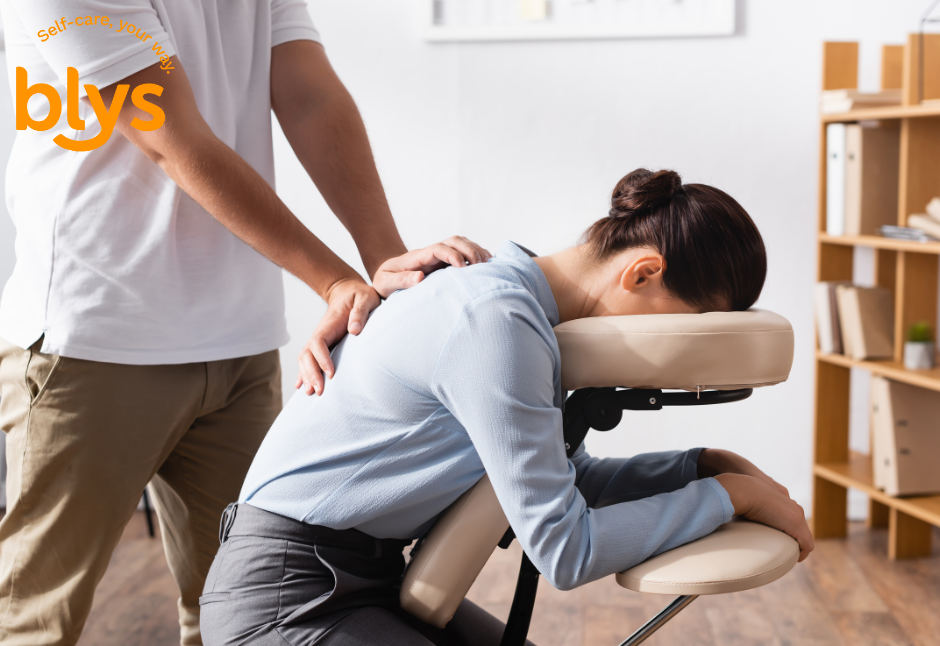
High-stress workplaces are common in the UK, from corporate offices and finance to tech and healthcare. Long hours, digital overload, and constant deadlines leave employees fatigued and struggling to stay focused. Stress doesn’t just affect wellbeing it reduces concentration, slows decision-making, and limits productivity.
Traditional breaks like coffee or a quick walk often aren’t enough to counter these pressures. Seated massage offers a practical alternative. Delivered in short sessions that fit easily into the workday, it helps release tension, improve focus, and provide an energy reset without disrupting workflow.
By addressing both mental strain and physical discomfort, seated massage is becoming a valuable tool in workplace wellness, giving employees the clarity and calm they need to perform at their best.
The Science of Stress and Focus at Work
In today’s fast-paced offices, stress is one of the biggest barriers to productivity. Employees are expected to juggle deadlines, constant emails, and back-to-back meetings, leaving little room for recovery. This constant pressure doesn’t just cause fatigue; it has measurable effects on how the brain and body function.
Elevated stress hormones like cortisol disrupt mental clarity, slow down decision-making, and increase the risk of burnout. Over time, this undermines both employee well-being and business performance.
Key insights:
- Stress weakens focus: High cortisol levels interfere with memory and concentration, making it harder to stay engaged and productive.
- Massage reduces stress hormones: Research shows even short sessions can lower cortisol while increasing serotonin and dopamine, which improve mood and focus.
- Wellness gaps remain: Corporate wellness programs often focus on gyms or mindfulness apps but overlook tactile options like seated massage that deliver immediate, evidence-based relief.
By closing this gap, seated massage offers more than relaxation; it provides employees with a quick, reliable reset during the day. For businesses, it represents a practical way to support sharper focus, greater resilience, and sustained performance in high-stress environments.
Just as seated massage restores focus during the workday, it can also help travelling employees overcome jet lag and fatigue as explained in this Blys guide.
Key Productivity Benefits of Seated Massage
Seated massage goes beyond relaxation it directly supports performance at work. Short, targeted sessions relieve tension, improve circulation, and create the mental clarity employees need to stay productive.
Core benefits include:
- Quick stress relief massage: A 15-minute session can significantly lower stress markers, helping employees feel calmer and more focused during demanding workdays.
- Sharper focus and clarity: By reducing muscle tension in the neck and shoulders, seated massage improves concentration and allows employees to process information more effectively.
- Energy boost: Improved blood circulation delivers oxygen and nutrients throughout the body, countering fatigue and the mid-afternoon slump.
- Mental reset: Short massage breaks act as micro-interventions, giving employees a chance to recharge without stepping away for long periods.
Evidence supports these outcomes. Workplace studies have linked massage to improved attention span, reduced anxiety, and higher accuracy in completing tasks. There is also evidence that regular massage sessions contribute to lower absenteeism and better overall job satisfaction.
By incorporating seated massage into the office routine, businesses provide their teams with an accessible, evidence-based tool for boosting focus and performance, while also showing a commitment to employee wellbeing.
Office Massage Benefits in High-Stress Industries
Seated massage is uniquely suited to address the intense demands faced in specific sectors. Here’s how it brings tangible benefits across three high-pressure industries:
- Finance & Legal: Professionals in these fields must make critical decisions under tight deadlines. A study on chair massage and decision-making indicates that such therapies can help mitigate stress-related impairment in cognitive processing, supporting clearer, more composed thinking in fast-paced environments.
- Tech & Start‑Ups: Long screen sessions and extended work hours contribute to both physical tension and burnout. Chair massage delivers quick, on-site muscle relief, offering a reset that helps maintain productivity without significant downtime.
- Healthcare & Emergency Services: Staff in these roles endure both physical strain and emotional overload. Studies show workplace massage reduces stress and enhances mental resilience nurses receiving regular short massages reported fewer aches, improved mood, and greater emotional recovery after shifts.
In each of these sectors, integrating seated massage into a broader corporate wellness massage strategy shifts it from being just a perk to a strategic tool. It helps teams perform more effectively by reducing stress, promoting mental clarity, and supporting physical recovery while also demonstrating an employer’s genuine commitment to employee wellbeing.
Why Seated Massage Works Better than Other Breaks
Breaks are essential in any workplace, but not all downtime delivers the same results. Coffee runs, screen breaks, or stretching can help in the moment, yet they often fall short in addressing the deeper physical and mental effects of stress. Seated massage provides unique benefits that make it a stronger investment for both employees and employers.
| Break Type | Benefits | Limitations | Seated Massage Advantage |
| Coffee breaks | Quick energy boost, social pause | Caffeine crash, doesn’t ease tension | Massage restores focus without dependency on stimulants |
| Screen breaks | Reduces eye strain, mental pause | Short-lived, no impact on body strain | Massage actively releases muscle tension and clears mental fatigue |
| Stretching | Improves flexibility, easy to do | Often skipped, not guided | Massage provides expert, targeted relief in minutes |
| Seated massage | Lowers cortisol, boosts dopamine and serotonin, improves circulation | Requires scheduling, but quick (15–20 min) | Combines physical, mental, and chemical reset for lasting productivity |
From a cost perspective, the value of seated massage is clear. A single short session reduces stress markers and sharpens concentration, lowering the likelihood of mistakes, fatigue, and absenteeism. Compared to the hidden costs of lost productivity, massage chair therapy is a highly cost-effective wellness solution.
By offering on-site seated therapy, companies ensure employees return to work recharged, focused, and ready to perform at their best.
Want to know how corporate massage keeps teams energised and focused? Learn more in this Blys article.
Implementation in Corporate Wellness Programs
For seated massage to make a real impact, it works best when integrated into regular wellness programs rather than offered as a one-off incentive. Many Brits companies now use it as part of their strategy to keep staff healthy, focused, and motivated.
Practical integration:
- Short sessions: Appointments usually run for 15–20 minutes, so employees can enjoy the benefits without losing valuable work time.
- On-site access: Massages are delivered directly in the office, using a portable massage chair. Staff remain fully clothed, which makes the process quick and non-disruptive.
- Positive feedback: Employees often describe feeling lighter, clearer, and more energised after sessions, which helps lift team morale and contributes to a more supportive work culture.
For employers, the return on investment is clear. A program of regular seated massage reduces the costs of absenteeism, improves engagement, and shows employees that their wellbeing is genuinely valued.
This is where Blys makes workplace massage seamless. With a network of qualified, vetted therapists, Blys delivers flexible corporate wellness massage services across the UK. Whether for small teams, large offices, or company events, Blys provides a reliable solution that fits easily into any wellness strategy.
Ready to make workplace wellness part of your culture? Explore Blys Corporate Massage and see how easy it is to schedule seated sessions that boost focus, reduce stress, and support your team’s productivity.
Evidence-Based Support for Massage in the Workplace
Massage is often seen as a luxury, but research consistently shows it produces measurable outcomes that matter in professional settings. By reducing stress chemistry and improving workplace wellbeing, seated massage provides benefits far beyond relaxation.
What the evidence shows:
- Lower stress hormones: Massage reduces cortisol while boosting serotonin and dopamine, helping employees feel calmer and think more clearly.
- Higher job satisfaction: Studies in healthcare workers link regular chair massage to less stress and greater morale, supporting engagement and retention.
- Fewer productivity losses: Worksite trials demonstrate reductions in blood pressure and stress, outcomes associated with fewer absences and sharper day-to-day performance.
Together, these findings show that massage is more than a wellness perk it is a science-backed intervention that supports the key drivers of performance. When businesses invest in seated massage, they are not just easing employee tension; they are actively improving focus, resilience, and productivity.
By grounding wellness strategies in evidence, companies can show they value their teams while achieving measurable returns through healthier, more engaged employees.
Practical Tips for Businesses Considering Seated Massage
Introducing seated massage into the workplace is straightforward, but a little planning can help companies get the most out of the program. By setting clear structures, creating the right environment, and engaging staff, businesses can turn massage from a “nice extra” into a genuine driver of wellbeing and performance.
Best practices for setup:
Creating the right framework from the start ensures seated massage sessions run smoothly and deliver maximum benefit for both employees and employers.
- Frequency and duration: Sessions of 15–20 minutes strike the right balance: long enough to deliver noticeable relief but short enough to avoid disrupting the day. Many companies find fortnightly or monthly visits work well, while high-stress periods may benefit from weekly options.
- Settings: A quiet room is ideal, allowing employees to fully relax. However, massage can also be delivered in open-plan areas with minimal setup, making it flexible for offices without dedicated space. Privacy screens can help where needed.
- Communication and engagement: Promote the program in advance, explain what seated massage involves, and encourage staff to share feedback. This helps normalise participation and shows employees their input shapes the wellness program.
When businesses take these steps, seated massage becomes more than just a wellness perk it turns into a consistent, well-managed program that employees look forward to and employers can rely on for measurable benefits.
Maximising ROI
Maximising the return on investment from seated massage comes down to planning and measurement. Companies can track outcomes by looking at absenteeism rates, productivity levels, or even simple employee surveys to capture feedback on stress reduction and engagement.
Timing also plays a big role in effectiveness. Scheduling sessions during periods of heightened pressure such as quarter-end reporting in finance, product launch cycles in tech, or peak holiday seasons in hospitality ensures that the support is delivered when staff need it most.
Finally, seated massage works best when it is positioned as part of a broader wellness strategy, complementing other initiatives like fitness programs, mindfulness activities, or ergonomic workplace improvements.
Reaching hybrid and remote teams
Blys’ mobile model ensures inclusivity. Therapists can visit employees working from home or in co-working hubs, so no one misses out on stress relief and productivity benefits. This adaptability makes seated massage a strong option for modern, flexible workplaces.
Stress Less, Focus More With Blys
Workplace stress is unavoidable, but how businesses respond to it makes all the difference. Seated massage has been shown to ease tension, sharpen concentration, and restore energy in just a short session, making it a powerful tool for maintaining productivity in high-pressure environments.
Beyond quick stress relief, it also contributes to long-term well-being by reducing the physical and mental toll of demanding work. By integrating seated massage into wellness programs, companies show employees that their health and focus are valued.
Unlike temporary fixes such as caffeine or screen breaks, seated massage provides a sustainable, evidence-based way to support performance and morale. It fits easily into busy schedules, is accessible to all staff, and delivers measurable outcomes in engagement, resilience, and productivity.
As workplaces continue to evolve, investing in strategies that support both well-being and efficiency is no longer optional; it’s essential. Seated massage stands out as a practical, cost-effective solution that benefits employees and organisations alike.
Explore flexible corporate massage programs with Blys and give your team the reset they need to perform at their best.





